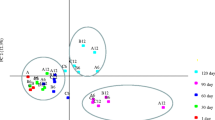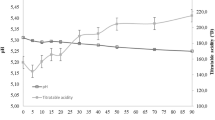Abstract
Lactobacillus delbrueckii (LD) is a species usually found in raw milk hard cooked cheeses. Present in raw milk, it grows in cheeses during ripening, but it can also be added in large concentrations with acidifying starter cultures. Its role in cheese proteolysis has been largely demonstrated, but its role in the formation of volatile compounds in cheeses remains to be documented. For this purpose, 16 experimental hard cooked cheeses were made from raw milk using adjunct cultures made up of Streptococcus thermophilus and Lactobacillus helveticus with the addition or not of LD, and ripened for 184 days. Bacterial populations and volatile compounds were monitored throughout ripening. The LD addition affected the early growth of the starters but not the dynamics of the native microbiota. LD had a major effect on proteolysis and on the composition of volatile compounds. Of the 85 volatile compounds identified in the cheeses, 6 of the 7 acids, 10 of the 16 aldehydes, 11 of the 17 alcohols, 10 of the 17 ketones, 10 of the 23 esters, and 4 of the 5 sulphur compounds were affected by the LD addition at one or more stages of ripening. At the end of ripening, levels of the 31 compounds affected by LD were higher in the cheeses with LD added, except one secondary alcohol and 2 methyl-ketones. The question of the effective involvement of LD in these observations, whether due to the metabolic activity of LD or interactions with other microbial populations, is raised.

Similar content being viewed by others
References
Curioni PMG, Bosset JO (2002) Key odorants in various cheese types as determined by gas chromatography-olfactometry. Int Dairy J 12:959–984
McSweeney PLH, Sousa MJ (2000) Biochemical pathways for the production of flavour compounds in cheeses during ripening: a review. Lait 80:293–324
Preininger M, Warmke R, Grosch W (1996) Identification of the character impact flavour compounds of Swiss cheese by sensory studies of models. Z Lebensm Unters For 202:30–34
Rychlik M, Bosset JO (2001) Flavour and off-flavour compounds of Swiss Gruyère cheese. Identification of key odorants by quantitative instrumental and sensory studies. Int Dairy J 11:903–910
Urbach G (1997) The flavour of milk and dairy products. II. Cheese: contribution of volatile compounds. Int J Dairy Technol 50:79–89
Beuvier E, Buchin S (2004) Raw Milk Cheeses. In: Fox P, Mc Sweeney PLH, Cogan TM, Guinee TP (eds) Cheese chemistry, physics and microbiology. Vol 1 General aspects, 3rd ed. Elsevier Ltd, London, pp 319–345
Bouton Y, Buchin S, Duboz G, Pochet S, Beuvier E (2009) Effect of mesophilic lactobacilli and enterococci adjunct cultures on the final characteristics of a microfiltered milk Swiss-type cheese. Food Microbiol 26:183–191
Thierry A, Deutsch S, Falentin H, Dalmasso M, Cousin F, Jan G (2011) New insights into physiology and metabolism of Propionibacterium freudenreichii. Int J Food Microbiol 149:19–27
Chamba JF (2000) Emmental cheese: a complex microbial ecosystem. Consequences on selection and use of starters. Sci Aliments 20:37–54
Charlet M, Duboz G, Faurie F, Le Quéré JL, Berthier F (2009) Multiple interactions between Streptococcus thermophilus, Lactobacillus helveticus and Lactobacillus delbrueckii strongly affect their growth kinetics during the making of hard cooked cheeses. Int J Food Microbiol 131:10–19
Biede S, Reinbold G, Hammond E (1977) Influence of Lactobacillus bulgaricus on commercial Swiss cheese. J Dairy Sci 60:123–125
Bouton Y, Guyot P, Dasen A, Grappin R (1994) Proteolytic activity of thermophilic lactobacilli strains isolated from starters and Comte II. Applications in cheese plants. Lait 74:33–46
Richoux R, Aubert L, Roset G, Kerjean JR (2009) Impact of the proteolysis due to lactobacilli on the stretchability of Swiss-type cheese. Dairy Sci Technol 89:31–41
Bouton Y, Guyot P, Dasen A (1996) Effects of interactions between milk and lactic starters on the ripening and quality of Comte cheese. Int Dairy J 6:997–1013
Kerjean JR, Condon S, Lodi R, Kalantzopoulos G, Chamba JF, Suomalainen T, Cogan T, Moreau D (2000) Improving the quality of European hard-cheeses by controlling of interactions between lactic acid bacteria and propionibacteria. Food Res Int 33:281–287
Thierry A, Maillard MB, Richoux R, Kerjean JR, Lortal S (2005) Propionibacterium freudenreichii strains quantitatively affect production of volatile compounds in Swiss cheese. Lait 85:57–74
Demarigny Y, Beuvier E, Buchin S, Pochet S, Grappin R (1997) Influence of raw milk microflora on the characteristics of Swiss-type cheeses. 2. Biochemical and sensory characteristics. Lait 77:151–167
Bugaud C, Buchin S, Hauwuy A, Coulon JB (2001) Relationships between flavour and chemical composition of Abondance cheese derived from different types of pastures. Lait 81:757–773
Christensen JE, Dudley EG, Pederson JA, Steele JL (1999) Peptidases and amino acid catabolism in lactic acid bacteria. Anton Leeuw 76:217–246
Bouton Y, Grappin R (1995) Comparison of the final quality of a Swiss-type cheese made from raw or microfiltered milk. Lait 75:31–44
Fornasari ME, Rossetti L, Carminati D, Giraffa G (2006) Cultivability of Streptococcus thermophilus in Grana Padano cheese whey starters. FEMS Microbiol Lett 257:139–144
Depouilly A, Dufrene F, Beuvier E, Berthier F (2004) Genotypic characterisation of the dynamics of the lactic acid bacterial population of Comte cheese. Lait. 84:155–167
Grappin R, Beuvier E, Bouton Y, Pochet S (1999) Advances in the biochemistry and microbiology of Swiss-type cheeses. Lait 79:3–22
Carcano M, Todesco R, Lodi R, Brasca M (1995) Propionibacteria in Italian hard cheeses. Lait 75:415–426
Nocker A, Camper AK (2009) Novel approaches toward preferential detection of viable cells using nucleic acid amplification techniques. FEMS Microbiol Lett 291:137–142
Bosset JO, Collomb M, Sieber R (1993) The aroma composition of Swiss Gruyère Cheese IV. The acidic volatile components and their changes in content during ripening. Lebensm Wiss Technol 26:581–592
Bosset JO, Liardon R (1984) The aroma composition of Swiss Gruyère Cheese. II. The neutral volatile components. Lebensm Wiss Technol 17:359–362
Thierry A, Maillard MB, Le Quéré JL (1999) Dynamic headspace analysis of Emmental aqueous phase as a method to quantify changes in volatile flavour compounds during ripening. Int Dairy J 9:453–463
Berdague JL, Jeunet R, Grappin R, Duboz G (1987) Ripening and quality of Gruyère of Comté cheese III. Influence of the ripening conditions on lactic acid and fermentation and on the amount of volatile fatty acids (Affinage et qualité du Gruyère de Comté III. Fermentation lactique et teneur en acides gras volatils des fromages de Comté). Lait 67:249–263
Ganesan B, Dobrowolski P, Weimer BC (2006) Identification of the Leucine-to-2-Methylbutyric Acid Catabolic Pathway of Lactococcus lactis. Appl Environ Microb 72:4264–4273
Dherbécourt J, Maillard MB, Catheline D, Thierry A (2008) Production of branched-chain aroma compounds by: links with the biosynthesis of membrane fatty acids. J Appl Microbiol 105:977–985
Falentin H, Henaff N, Bivic P, Deutsch S, Parayre S, Richoux R, Sohier D, Thierry A, Lortal S, Postollec F (2012) Reverse transcription quantitative PCR revealed persistency of thermophilic lactic acid bacteria metabolic activity until the end of the ripening of Emmental cheese. Food Microbiol 29:132–140
Ganesan B, Stuart MR, Weimer BC (2007) Carbohydrate starvation causes a metabolically active but nonculturable state in Lactococcus lactis. Appl Environ Microb 73:2498–2512
Sgarbi E, Bottari B, Gatti M, Neviani E (2014) Investigation of the ability of dairy nonstarter lactic acid bacteria to grow using cell lysates of other lactic acid bacteria as the exclusive source of nutrients. Int J Dairy Technol 67:342–347
Richoux R, Faivre E, Kerjean JR (1998) Effect of NaCl content on lactate fermentation by Propionibacterium freudenreichii in small scale Swiss-type cheeses. Lait 78:319–331
Thierry A, Salvat-Brunaud D, Maubois J (1999) Influence of thermophilic lactic acid bacteria strains on propionibacteria growth and lactate consumption in an Emmental juice-like medium. J Dairy Res 66:105–113
Ganesan B, Weimer B (2007) Amino acid metabolism in relationship to cheese flavor development. In: Weimer BC (ed) Improving the flavour of cheese. CRC Press, Woodhead Publishing Limited, Cambridge, pp 70–101
Smit G, Smit BA, Engels WJM (2005) Flavour formation by lactic acid bacteria and biochemical flavour profiling of cheese products. FEMS Microbiol Rev 29:591–610
Helinck S, Le Bars D, Moreau D, Yvon M (2004) Ability of thermophilic lactic acid bacteria to produce aroma compounds from amino acids. Appl Environ Microb 70:3855–3861
Williams AG, Noble J, Banks JM (2001) Catabolism of amino acids by lactic acid bacteria isolated from Cheddar cheese. Int Dairy J 11:203–215
Gobbetti M, De Angelis M, Di Cagno R, Mancini L, Fox PF (2015) Pros and cons for using non-starter lactic acid bacteria (NSLAB) as secondary/adjunct starters for cheese ripening. Trends Food Sci Tech 45:167–178
Williams AG, Withers SE, Brechany EY, Banks JM (2006) Glutamate dehydrogenase activity in lactobacilli and the use of glutamate dehydrogenase-producing adjunct Lactobacillus spp. cultures in the manufacture of Cheddar cheese. J Appl Microbiol 101:1062–1075
Amarita F, Requena T, Taborda G, Amigo L, Pelaez C (2001) Lactobacillus casei and Lactobacillus plantarum initiate catabolism of methionine by transamination. J Appl Microbiol 90:971–978
Aubel D, Germond JE, Gilbert C, Atlan D (2002) Beta-Cystathionase activity within the Lactobacillus delbrueckii specium. Sci Aliments 22:161–166
Imhof R, Glaettli H, Bosset JO (1995) Volatile organic compounds produced by thermophilic and mesophilic single strain dairy starter cultures. Lebensm Wiss Technol 28:78–86
Keenan TW, Lindsay RC (1967) Dehydrogenase activity of Lactobacillus species. J Dairy Sci 50:1585–1588
Ott A, Germond J, Chaintreau A (2000) Origin of acetaldehyde during milk fermentation using 13C-labeled precursors. J Agric Food Chem 48:1512–1517
Zourari A, Accolas J, Desmazeaud M (1992) Metabolism and biochemical characteristics of yogurt bacteria. A review. Lait 72:1–34
Keenan TW, Bills DD (1968) Volatile compounds produced by Propionibacterium shermanii. J Dairy Sci 51:797–799
Liu SQ, Holland R, Crow VL (2004) Esters and their biosynthesis in fermented dairy products: a review. Int Dairy J 14:923–945
El Soda M, Abd El Wahab H, Ezzat N, Desmazeaud MJ, Ismail A (1986) The esterolytic and lipolytic activities of lactobacilli. II. Detection of the esterase system of Lactobacillus helveticus, Lactobacillus bulgaricus, Lactobacillus lactis and Lactobacillus acidophilus. Lait 66:431–443
Oliszewski R, Medina RB, Gonzalez SN, Perez Chaia AB (2007) Esterase activities of indigenous lactic acid bacteria from Argentinean goats’ milk and cheeses. Food Chem 101:1446–1450
Urbach G (1993) Relations between cheese flavour and chemical composition. Int Dairy J 3:389–422
Acknowledgements
We are grateful to Dominique Lefier, Francis Faurie, Romain Palme, and Marie-Odile Coquillard for their technical assistance, Eric Beuvier for his read-through of the manuscript and Helen Lamprell for her review of English language.
Author information
Authors and Affiliations
Corresponding author
Ethics declarations
Conflicts of interest
The authors declare no conflicts of interest.
Compliance with ethics requirements
This article does not contain any studies with human or animal subjects.
Rights and permissions
About this article
Cite this article
Buchin, S., Duboz, G. & Salmon, JC. Lactobacillus delbrueckii subsp. lactis as a starter culture significantly affects the dynamics of volatile compound profiles of hard cooked cheeses. Eur Food Res Technol 243, 1943–1955 (2017). https://doi.org/10.1007/s00217-017-2899-x
Received:
Revised:
Accepted:
Published:
Issue Date:
DOI: https://doi.org/10.1007/s00217-017-2899-x




